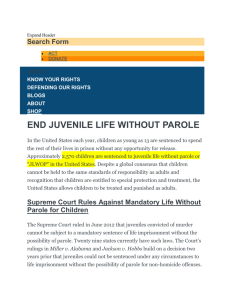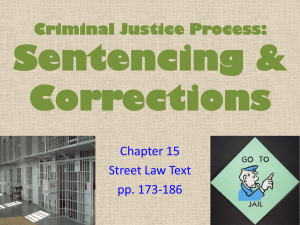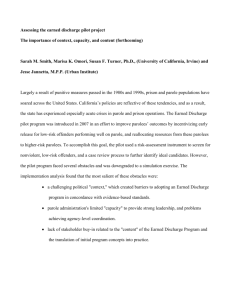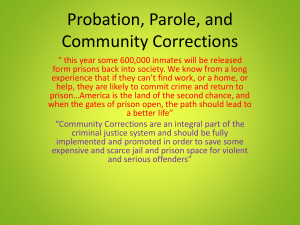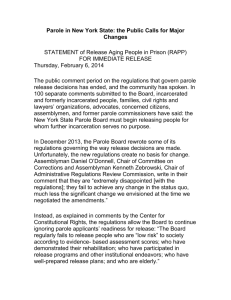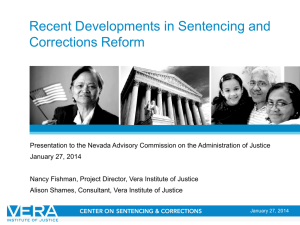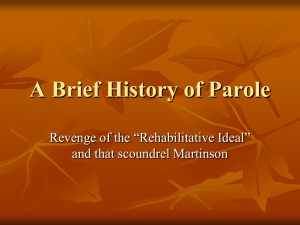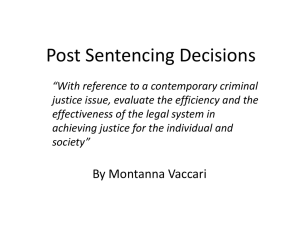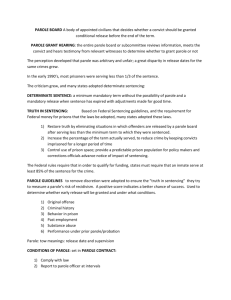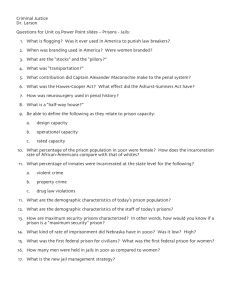DHS_Changing_Trax_ presentation
advertisement
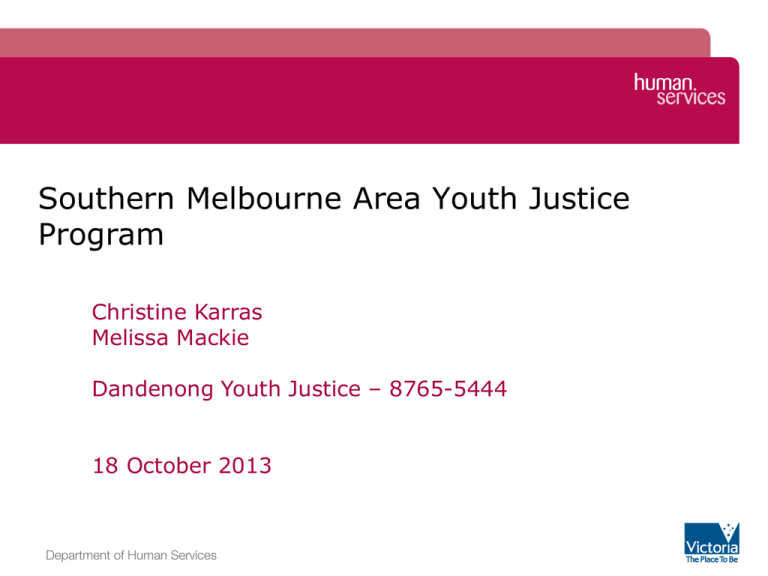
Southern Melbourne Area Youth Justice Program Christine Karras Melissa Mackie Dandenong Youth Justice – 8765-5444 18 October 2013 Objectives • Youth Justice objectives are to: • where appropriate, support diversion of young people charged with an offence from the criminal justice system • minimise the likelihood of reoffending and further progression into the criminal justice system through supervision that challenges offending behaviours and related attitudes and promotes pro-social behaviours • work with other services to strengthen community-based options for young people enabling an integrated approach to the provision of support that extends beyond the court order • engender public support and confidence in the Youth Justice service. Philosophy underpinning practice • Custody is last resort • Evidence based practice • Community integration Matters taken into account when sentencing • The need to strengthen & preserve the relationship between the child & the family; • The desirability of allowing the child to live at home; • The desirability of allowing the education, training or employment to continue without interruption; • The need to minimise the stigma to the child resulting from a court determination; • The suitability of the sentence of the child; • If appropriate, the need to ensure that the child is aware that they must bear a responsibility for any action against the law; • The need to protect the community. Hierarchy of Children’s Court Sentences • Non-Supervisory Orders Fines Good Behaviour Bond Accountable Undertaking Undertaking Dismiss Charge • Supervisory Order *Intensive Bail Supervision *Supervised Deferral of Sentence Probation Order (without conviction) Youth Supervision Order (with or without conviction) Youth Attendance Order (with conviction) Youth Justice Centre Order (with conviction) Youth Parole Order (with conviction) ‘Dual track’ system • Section 32 of the Sentencing Act 1991 legislates that some 18 to 20 year olds convicted of serious offences can be detained in a youth justice centre instead of an adult prison if the court believes the young person has reasonable prospects for rehabilitation, or is particularly impressionable, immature or likely to be subjected to undesirable influences in an adult prison. This is commonly referred to as the 'dual track' system. Youth Justice Custodial Services • Responsible for the operation and management of youth justice centres: • Parkville Youth Justice Precinct -young women aged 10-21 -young men sentenced in the Children’s Court Malmsbury Youth Justice Centre -young men sentenced in the Magistrates’, County or Supreme Courts. The Youth Parole Board • The Youth Parole and Youth Residential Boards are independent statutory bodies created under sections 442 and 431 respectively of the Children, Youth and Families Act 2005 (Vic). • The Youth Parole and Youth Residential Boards exercise jurisdiction over all young people sentenced by a court to a period of detention in a youth justice centre (15-20 years) or youth residential centre (1014 years) and over young people transferred by the Adult Parole Board from imprisonment in an adult prison to serve their sentence in a youth justice custodial centre. Board membership • • • ChairpersonHis Honour Judge Michael Bourke Alternate ChairpersonHis Honour Judge Ross Howie • • Community membersDeborah Bryant Alternate Community memberYvonne Luke • Helen Dimopoulos Carmel Guerra • • Departmental memberVictor Gordon Alternate Departmental Member Kathryn Lamb Factors influencing the Board’s decision making • • • • • • • • • interests of/risk to the community capacity for parole to assist the young person’s rehabilitation intentions and comments of the sentencing authority the nature and circumstances of the offences young person’s criminal history previous community based dispositions and compliance family and community support networks release plans reports, assessments and recommendations made by a variety of professionals, including medical practitioners, psychologists, psychiatrists, custodial staff, parole officers and support agencies • submissions made by the young person, victims, the young person’s family, friends and potential employers. Youth Parole • Parole provides an opportunity for young people to serve part of their custodial sentence in the community. This enables reintegration of the client back into the community in a planned way with support and supervision from regional youth justice. • The client remains under the jurisdiction and monitoring of the Boards until the completion of their parole. • The timelines for consideration of parole is a decision made by the Boards when sentenced to YRC or YJC. Common referrals Alcohol & Other Services (AO&D) Mental Health Counselling General health Recreation Employment and Education Literacy & Numeracy Offence Specific, ie MVO, MAPPS, Violence Prevention Youth Justice Community Support Service Housing Family/interpersonal counselling L2P Cultural support, ie KISP, KYJ & Cultural Connections A day in the life of a Youth Justice worker • On any given day, as a YJ worker you might….. • • • • • • • • • • • Support a young person at Court. Attend a care team meeting. Write case notes. Write a court report. Visit and assess proposed accommodation. Support/debrief a colleague. Have supervision with a young person. Advocate for a young person to be accepted into a program. Try and locate a young person whose whereabouts is unknown. Have supervision with their supervisor. Visit a young person in custody, ie in a youth justice centre, in a remand facility or an adult prison. Take a young person to have their mental health assessed. Build rapport with a young person by participating in a recreational activity. Mediate between a young person and their parent. Prosecute the breach of a young person’s YJ Order in court. Assist young person with their independent living skills. • • • • •


